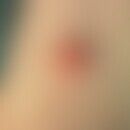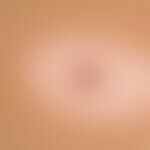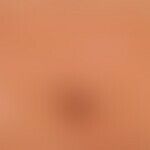Synonym(s)
circumnaeval vitiligo; Halo dermatitis around nevus cellnaevi; Halo-eczema around Naevuszellnaevi; Halonaevus; Halo-Naevus; halo nevus; Leucoderma centrifugum acquisitum; Perinaevic vitiligo; Sutton Nevus; Sutton's nevus; Vitiligo perinaevic
HistoryThis section has been translated automatically.
Sutton, 1916
DefinitionThis section has been translated automatically.
Incomplete or completely depigmented melanocytic nevus with unpigmented halo. Mostly occurring singly, the phenomenon of halon depigmentation around a melanocytic nevus can also occur multiple times.
You might also be interested in
Occurrence/EpidemiologyThis section has been translated automatically.
Occurring as a random finding in patients with numerous melanocytic nevi. Common in patients with vitiligo and metastatic melanoma.
EtiopathogenesisThis section has been translated automatically.
Probably immunological reaction with disturbance of melanogenesis and death of melanocytes. Familial accumulation described.
ManifestationThis section has been translated automatically.
Mostly occurring in adolescents or young adults during the 2nd-3rd decade of life.
LocalizationThis section has been translated automatically.
Mostly trunk localized, especially on the back.
ClinicThis section has been translated automatically.
An oval or circular white patch 0,5-1,0 cm (or larger) in diameter surrounding a centrally located light to dark brown papule (melanocytic nevus). Pink discoloration and depigmentation of the central melanocytic nevus are possible as well as repigmentation of the depigmented yard. In some cases only the white, circular or oval spot is impressive.
HistologyThis section has been translated automatically.
Central melanocytic nevus, possibly with cellular inflammatory reaction, surrounded by a halo without dopapositive melanocytes, melanin in melanophages.
TherapyThis section has been translated automatically.
A therapy is not necessary. Excision only in case of clinical suspicion of malignancy, usual criteria ( ABCD-rule) for the need of excision of melanocytic nevi. Always histological control of the excidate! Caution! Exact clinical information on the histological accompanying sheet, because of the danger of misinterpretation!
LiteratureThis section has been translated automatically.
- Montag A et al (1990) The halo-naevus (Sutton naevus, Leukoderma aquisitum centrifugum). Act Dermatol 16: 58-62
- Ohtsuka T (2009). Multiple Sutton nevi: Hypomelanocytic halo development around 28 melanocytic nevi. J Dermatol 36:355-357
- Petit A et al (1994) Coexistence of Meyerson's with Sutton's naevus after sunburn. Dermatology 189: 269-270
- Ramon R et al (2000) Progression of Meyerson's naevus to Sutton's naevus. Dermatology 200: 337-338
- Steffen C et al (2003) The man behind the eponyms: Richard L Sutton: periadenitis mucosa necrotica recurrens (Sutton's ulcer) and leukoderma acquisitum centrifugum-Sutton's (halo) nevus. At J Dermatopathol 25: 349-354
- Sutton RL (1916) An unusual variety of vitiligo (leucodema acquisitum centrifugum). Journal of Cutaneous Disease Including Syphilis (Chicago) 34: 797-800
- Weyant GW et al (2015) Halo nevus: review of the literature and clinicopathologic findings. Int J Dermatol 54: e433-435
Incoming links (11)
Circumnaeval vitiligo; Halo dermatitis around nevus cellnaevi; Halo-eczema around naevuszellnaevi; Halo-naevus; Juvenile dermatomyositis; Leucoderma centrifugum acquisitum; Meyerson-naevus; Naevus melanocytic common; Poliosis; Sutton nevus; ... Show allDisclaimer
Please ask your physician for a reliable diagnosis. This website is only meant as a reference.














